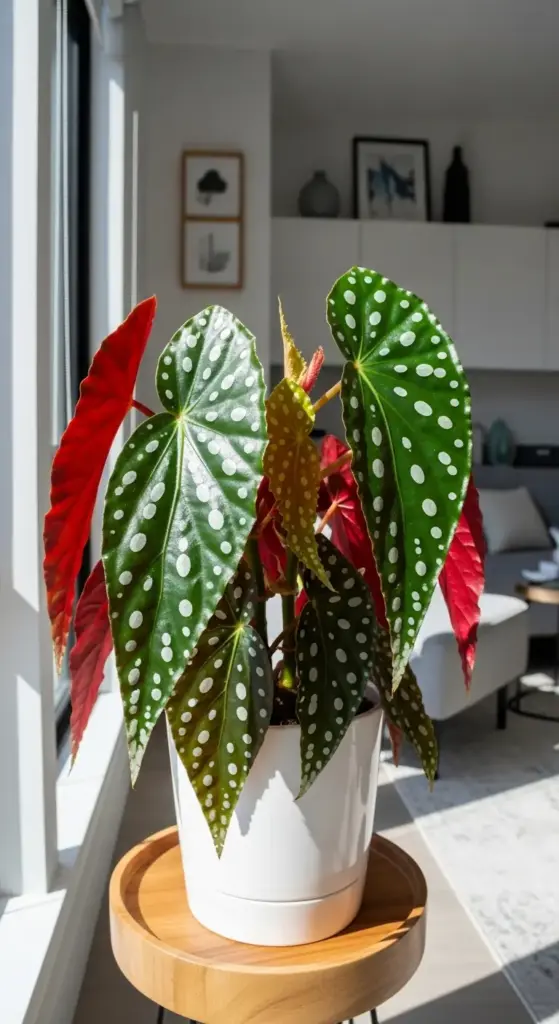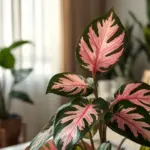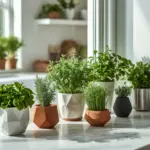3. Begonia Maculata ‘Polka Dot Begonia’

I’ll never forget the first time I saw a Begonia Maculata in person – I literally stopped mid-conversation and stared. Those silver polka dots looked so perfect, I was convinced someone had painted them on.
Turns out nature is just showing off sometimes.
This plant single-handedly changed my opinion about begonias. I used to think they were fussy, old-fashioned plants that belonged in my grandmother’s garden, not my modern apartment.
Why This Spotted Beauty Breaks All the Begonia Rules
Here’s the thing about traditional begonias – they’re drama queens. Too much water, they rot. Too little, they sulk. Wrong humidity, they drop leaves like it’s their job.
The Polka Dot Begonia threw that rulebook right out the window.
This variety is surprisingly resilient compared to its high-maintenance cousins.
I’ve had mine for two years now, and it’s survived my learning curve, a cross-country move, and that time I forgot about it during a work crisis for three weeks. Try that with a rex begonia – I dare you.
The secret is in those thick, waxy leaves. They’re way more drought-tolerant than the papery leaves on other begonia varieties, which means less stress for both you and the plant.
Lighting That Actually Works in Real Homes
Every begonia care guide I read initially made it sound like you needed some kind of perfect greenhouse setup. Total nonsense.
My Begonia Maculata sits about 4 feet from an east-facing window and absolutely thrives. It gets maybe 3-4 hours of direct morning light, then bright indirect light for the rest of the day.
The key is avoiding harsh afternoon sun – that’ll actually fade those gorgeous silver spots you’re trying to show off.
I’ve experimented with different locations around my apartment, and honestly, this plant is way more flexible than people make it out to be. It’s done well in my bedroom with just a north-facing window, though it grows a bit slower there.
If you’re dealing with lower light situations, just rotate it weekly so all sides get equal exposure. The plant will tell you if it’s unhappy – the stems get leggy and reach toward the light.
The Secret to Those Instagram-Worthy Silver Spots
Okay, this is where I made my biggest mistake initially. I thought those silver polka dots were just genetic and would appear no matter what.
Wrong. So very wrong.
The spotting intensity is directly related to light quality and plant maturity. My first Begonia Maculata had maybe 30% of the spots I see on it now, and I was convinced I’d gotten a dud.
Bright, indirect light is what really makes those spots pop. Too little light and they fade to barely visible. Too much direct sun and they actually get washed out.
The other game-changer? Letting the plant get slightly root-bound. I know it sounds counterintuitive, but a little stress actually encourages better variegation and spotting.
I repot mine only when absolutely necessary – maybe every 18-24 months instead of annually like other plants.
Styling This Showstopper in Your Space
The Polka Dot Begonia is basically the perfect statement plant for modern interiors. Those silver spots catch light in the most amazing way, creating this subtle shimmer effect throughout the day.
It pairs beautifully with neutral color schemes – think whites, grays, and natural wood tones.
I’ve got mine in a simple white ceramic pot that lets the foliage be the star. The red undersides of the leaves add just enough color contrast without being overwhelming.
For contemporary spaces, try placing it where it can be backlit slightly – maybe on a plant stand near a window. The light filtering through those spotted leaves creates the most gorgeous shadow patterns on the wall.
It also photographs incredibly well, which doesn’t hurt if you’re into sharing your plant setup online. Those spots are basically nature’s Instagram filter.
Busting the Biggest Begonia Myths
Let me clear up some nonsense I believed for way too long about begonia care.
Myth #1: Begonias need constant humidity. My apartment hovers around 40-45% humidity year-round, and my Polka Dot Begonia couldn’t care less.
Myth #2: They’re impossible to propagate. Actually, stem cuttings root super easily in water. I’ve successfully propagated mine three times now.
Myth #3: They need special soil. Regular potting mix with some perlite for drainage works perfectly fine.
The biggest myth though? That begonias are high-maintenance. This variety is honestly easier than most of my other plants.
I water when the top inch of soil is dry, give it decent light, and pretty much ignore it otherwise. Sometimes the best plant care is just leaving them alone.
Ready for a plant that’s so dramatic it’ll make your guests gasp? Hit “next” to meet the Alocasia Black Velvet – the gothic beauty with leaves so dark and velvety, people will think you’re growing shadows in your living room!









GIPHY App Key not set. Please check settings